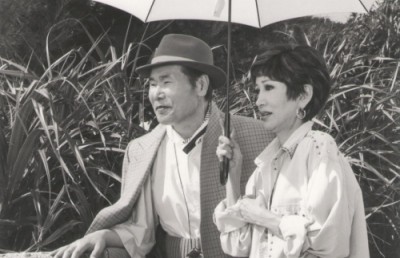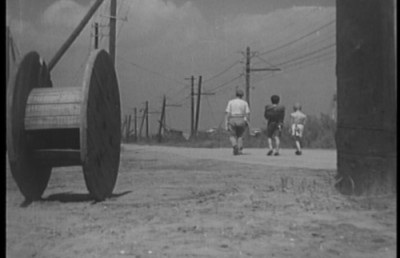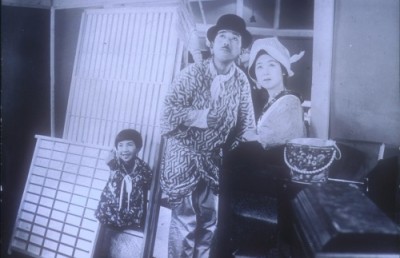Individualism in the Land of the Rising Sun: Youth and Rebellion on the Cusp of the Japanese New Wave
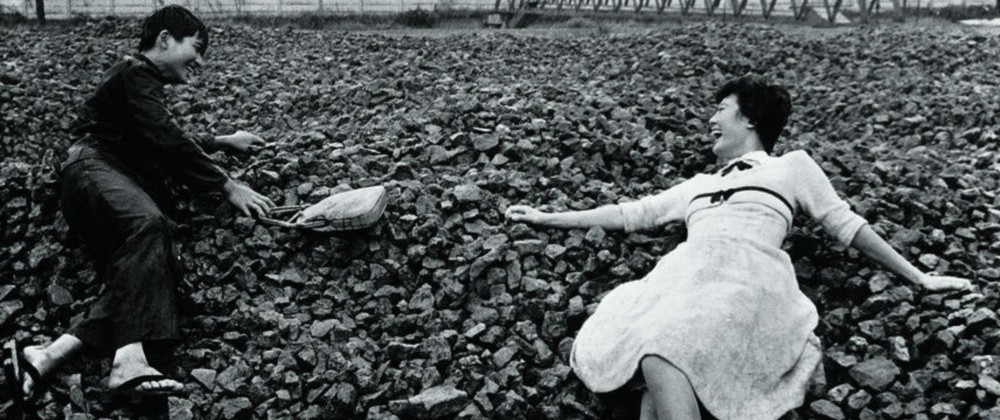
Les gens sensibles et perspicaces ont alors reconnu, dans le bruit d’une jupe de femme qu’on déchire, dans le vrombissement d’un canot automobile renversant et tuant le frère ainé, le chant annonciateur d’un nouveau printemps du cinéma. - Nagisa Oshima, 1958.
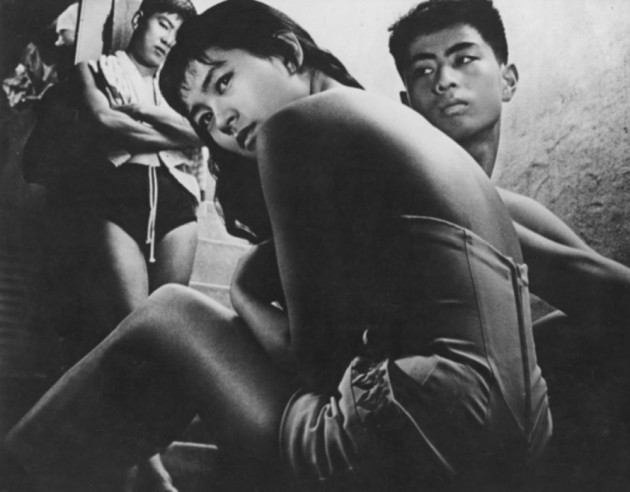
Beautiful bored youth in Crazed Fruit
Kô Nakahira was born in 1926, Yasuzo Masumura in 1924 and Nagisa Oshima in 1932. Together, those three men brought a revolution to the Japanese cinematic landscape in the mid to late-50s. They were forebears and members of a new generation that would be dubbed the Japanese New Wave. Each, in their own way, tried to create a new film language to comment on the socio-political state of Japan and on the younger generation who had to at once rebuild and live with the scars of war. With their films Crazed Fruit (Kô Nakahira, 1956), Kisses (Yasuzo Masamura, 1957) and A Town of Love and Hope (Nagisa Oshima, 1959), these directors tried to confront multiple subjects, but two that recur in all of them are that of youth and rebellion. It becomes clear that those movies, through their use of these themes, show an evolving Japan where individualism is replacing traditional group mentality.
It is important to understand both the historical and cinematic context surrounding the three films. They arrived at a very specific and eventful time in the Japanese film industry and in Japanese society as a whole. The Japan of 1956 is a fundamentally different Japan than the one of the 1930s. For one, it is a post-war Japan, a defeated Japan and a Japan which, while no longer under American occupation, is still under American influence. A popular rallying cry from the post-war period, “Demilitarization and Democratization,” highlights an extensive transition in Japanese politics from a warring unified empire that sought “the creation of a broader imperium in Asia” to a nation convinced that the “destruction of the militarized state was essential to democratize Japan, and only the creation of a genuinely democratic nation could prevent the danger of future Japanese militarism” (Dower 3). The ultimate goal became “Peace and Democracy.”
During this period, domestic political debates became “struggles concerning power, participation, national priorities and competing visions of fairness, well-being, and social justice” (Dower 4). Two moments of policy-making would further crystallize post-war Japan’s newfound social conscience, creating the immediate context for the making of Crazed Fruit in 1956. The first is the “San Francisco System,” the “international posture Japan assumed formally when it signed a peace treaty with forty-eight nations in San Francisco in September 1951 and simultaneously aligned itself with the cold-war policy of the United States” (Dower 4). This event also brought an end to the American occupation of Japan. The second is the “1955 system,” which brought about the creation of the Liberal Democratic Party, which would rule continuously for decades, and “signifies a domestic political structure characterized by an internally competitive but nonetheless hegemonic conservative establishment and a marginalized but sometimes influential liberal and Marxist opposition” (Dower 4).
By 1956, Japan had mostly finished the task of post-war reconstruction and was entering a long period of economic growth, which would last until well into the 1990s and make Japan a second world economic power second only to the United States. This growth would come to be known as the “Japanese post-war economic miracle,” and was achieved through a close link between government and industries (Hein 104-5), as well as a stronger consumer class with more spending power (Hein 114). These circumstances would lead to the transition from an industrializing country that “prizes group identity, stability, respect for elders and their traditions, and a certain reluctance to express one’s feelings publicly” (Desser 1) to “a rich consumer society and capitalist state” (Dower 5). They would also lead to a heavy Western influence and a fundamental shift in the younger generation’s social conscience. This generation and their new views shaped by the rapid changes in the country would become the focus and the lens through which Nakahira, Masumura and Oshima would question society and notions concerning the place of individuality.
One of the first films to tackle themes of youth and rebellion using a more modern and youthful sensibility is Nakahira’s Crazed Fruit . Nakahira was allowed greater freedom with this film because of the relative success of the taiyozoku_ (“youth films”) genre (Ritchie 181). _Crazed Fruit is the final of an unofficial trilogy of “Sun Tribe” films, all of which were based on Shintaro Ishihara’s novels about rich, disaffected youths spending their summers in beach towns (Sato 212). It tells the story of two brothers fighting for the affection of an angelic nude model and ends in nautical tragedy after the older sibling kidnaps the girl. The movie distances itself from the other “Sun Tribe” films and other movies dealing with youth to become a vital precursor to the Japanese New Wave through its innovative style and textual questioning of the values of its characters, which Japanese critic Tadao Sato describes as having “captured the sense of intoxication of the original and expressed Ishihara’s premonition that these rich youths who had been raised without restraints were the harbingers of an age of rapid economic growth and free sex” (213).
The forms of rebellion that the youthful characters engage in, except for the bloody finale, are less serious than those of some of the later films, and could be considered as simple hooliganism. But as a young Oshima saw, Crazed Fruit’s willingness to experiment with a faster editing style and a less solemn tone, and to luxuriate in sensuality proved an important break from the traditional forms of Japanese cinema such as melodramas and historical dramas that have “un lien étroit avec la structure archaïque de la société japonaise et l’idéologie de ceux qui vivent dans des rapports sociaux engendrés par cette structure” (Oshima 21). As Oshima sees it, Crazed Fruit was an important step in the slow shedding of the “archaic” aspects of Japanese society, like the group mentality, because of its innovative form. For example, the final scene with the boat accident where the space, broken by quick-fire editing and extreme change in framing, becomes an almost abstract representation of the animosity between the brothers, with one circling the other’s stopped boat, is a far cry from the more theatrical staging of the popular melodramas of the time (Standish 179). Nakahira does seem to question if that disassociation from traditional values is a wise choice. Apart from the obvious “crime does not pay” ending, where the characters are punished for transgressing the rigid codes of Japanese society, there is a scene early in the movie where characters discuss their boredom and their lack of anything resembling passion, which Nakahira films almost like a confession, with a close-up on the characters’ faces and the camera tilted to the side to show their state of unbalance. In this scene, they are criticizing and mocking the dreams the older generations have for them (“they want us to be captains of industry,” one of them sneers) as being boring. They say they are going to find their own way. This scene seems almost like a manifesto for the “Sun Tribe.” But Nakahira undercuts their philosophy of boredom and individuality by having his main character call them out on their lack of ambition and plan to change things. The characters argue back, asking what he thinks they should do, but he has no answer. Nakahira doesn’t explicitly say that the traditional way is superior to the hedonistic individualism of the youngsters, but he does show a more nuanced and fearful reaction to the rapid change in Japanese society and its effect on a bored youth than that of Oshima and Masumura’s films.
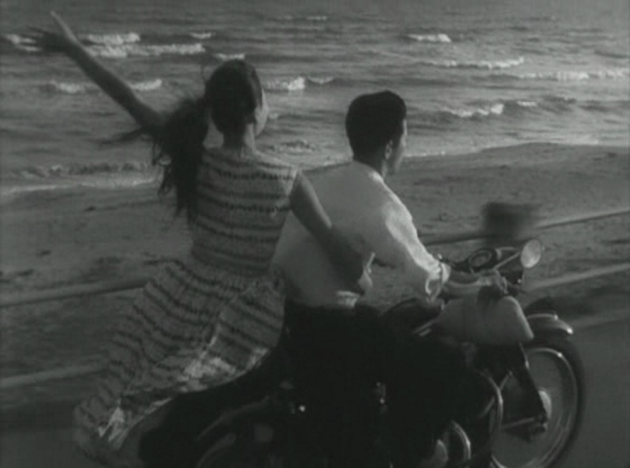
Rebellious youth on a spree in Kisses
The other film that Oshima saw as an important precursor to a new movement in Japanese cinema is Masumura’s Kisses (Oshima, 20), which tells the story of a young man and woman who meet in jail when they are both visiting their respective fathers and bond over their need to raise a large sum of money to bail their progenitors out. They instead decide to spend the day together, blowing the little money they win at the racetrack. What sets the movie apart is the attitude of the main character. As Sato puts it:
At the time of its release, film critics ignored Kisses because it seemed to conform to the well-worn genre of films about youth (seishun-eiga ). However, as was later evident, Masumura rejected the old formulas of the genre, and his hero was neither mild-mannered, romantic, nor especially good-looking, but rather audacious and perpetually angry. He was not the first Japanese version of the angry young man – rich, profligate youths had to some extent raised hell before him – but he was the most significant because he was a poor boy from the masses. In contrast to previous youthful heroes, he gives vent to his frustrations through exaggerated actions rather than through languishing melancholically, for sympathy was the last thing he wanted. Thus there are no atmospheric props or sentimental effects in Kisses, and the young hero is going to fulfill his thwarted needs through action alone. (210)
This angry hero also distances Kisses from the “Sun Tribe” films, where the blame for anti-social behaviour could be easily placed on the corrupting effects of affluence. Here, the main character comes from the large post-war middle class. His debts and problems come from his father, an unsubtle metaphor for the predicament of the younger generation who had to live with the recent scars of a losing war. Masumura further drives a wrench between the generations by showing the father as unapologetic and even bragging about his successful foray into election fraud. The young hero is thus positioned as Japanese youth, in all its anger and rebellion, in opposition to the older generation. This becomes evident in the movie’s formal innovations through fast-editing, daring camera angles and ambitious camera movements.
The figure of the angry youth also breaks from the trend of Japanese humanist movies where the main characters simply accept their predicament. “Masumura refused to recognize this denouement, stating that he ignored social environment on purpose so as to portray people who act like maniacs, thereby calling attention to the ego and expressing himself by exaggerating it” (Sato 212). In this film, the ego is not seen as a detrimental thing, but as a vital part of a transition from a society ruled by group mentality to one where the individual has a higher importance. By showing a character who takes control of his own destiny and isn’t afraid to express himself, Masumura portrays and encourages the changes happening in Japanese social conscience.
Masumura adds nuance to his support of a more modern Japan by showing the problems inherent in a purely capitalistic society. The main character’s mother, who abandoned him before the movie, refuses to lend her son bail money because, as she puts it, he is not worth the investment. This indictment of human life becoming a commercial factor is overturned by the end of the film, where the mother and son reconnect and help the girl and her father. This happy ending seems to proclaim a better relationship between generations, where individualism and humanism combine to triumph over unchecked capitalism. This return to family values offers a benign version of the overzealous patriotism that lead to WWII, creating a society where the individual is valued without glorifying selfishness.

Alienated youth in A Town of Love and Hope
Finally, Oshima’s A Town of Love and Hope is both the beginning of the Japanese New Wave and the most pure elegy of rebellion and individualism of the films studied. The movie follows a young boy who sells a pigeon that is trained to always return. This scheme destroys the relationship the boy builds with a rich girl who bought this pigeon. After getting caught, he destroys his pigeon coop and the girl kills the animal, showing an extreme break between the classes. Having the rich girl destroy the pigeon, the boy’s “object of desire and rebellion” (Turim 30) and the only thing linking the two classes, doesn’t stop the boy from becoming a true rebel, because he also takes part in the destruction. Sato sees the boy’s act as the ultimate form of rebellion:
If he apologized for his act, he would have to admit that what he was forced into doing earlier was wrong, something his self-respect would not permit. Nor would it allow him to continue selling his pigeon, for then he would be stuck with the juvenile delinquent label for good and his protest would go unnoticed. In order to become a true rebel against society, he angrily demolishes his means of delinquent behaviour. He rejects not only mending his ways but also the image of the pitiable juvenile delinquent. By simply asserting, “I am myself” he brings up the issue of the autonomy of rebellion. (215)
Oshima creates a character that can only rely on himself in a broken society where classes are divided and the poor are forced to fend for themselves. The boy becomes the ultimate individualist, refusing even the system that is capitalism. As opposed to Nakahira, who saw desperation and boredom in the jaded youth of Japan, and Masumura who valued individualism but was scared of its logical consequences, Oshima advocates true self-reliance without a system meant to perpetuate class distinctions and create victims. The film rejects both the American ideological hegemony and the archaic aspects of Japanese society. This view of pure individuality against a society full of ingrained systems meant to subjugate its citizen is a truly radical statement by Oshima, especially given its apolitical nature. The film does not seem to push communist or libertarian ideals, but rather liberty from corrupt and self-serving institutions. A Town of Love and Hate therefore becomes the ultimate representation of individualism without reservation or fear.
Crazed Fruit, Kisses and A Town of Love and Hope all tackle the themes of youth and rebellion to comment on the state of individualism in late 1950s Japan in a unique and personal way. Nakahira’s film seems to argue for a return to the traditional value of social unity by undercutting his characters’ lifestyle and punishing their transgressions with a violent ending. Kisses expresses a higher opinion of the value of individualism in modern Japan, but does warn the audience against the evils of the extremes of capitalism, and is careful to reinforce family values. Oshima’s movie is the most extreme in its representation of rebellion as a means of gaining individuality in an overbearing society, by showing a truly independent character that refuses to be made part of the system of Japanese society. These films showcase the evolution of the Japanese mindset from a strong group mentality toward a more democratic individualism. They also present the problems inherent in a country rethinking its basic philosophy. The three films each provide a different answer to the question of the changing meanings of the individual in society and show young artists discovering and attempting to express their political beliefs. The Japanese New Wave would later drift to the political left and support movements like the 1968 student strike, but, at this juncture, everything seemed possible for a young generation of filmmakers and citizens. And evidently, everything was.
Bibliography
A Town of Love and Hope . Dir. Nagisa Oshima. Perf. Hiroshi Fujikawa, Yuki Tominaga. Shochiku, 1959. Online.
Crazed Fruit . Dir. Kô Nakahira. Perf. Yujiro Ishihara, Masahiko Tsugawa. Nikkatsu, 1956. DVD.
Desser, David. Eros Plus Massacre: An Introduction to The Japanese New Wave Cinema . Bloomington : Indiana University Press, 1988. Print.
Dower, John W. “Peace and Democracy in Two Systems: External Policy and Internal Conflict.” Postwar Japan as History . Ed. Andrew Gordon. Los Angeles: University of California Press, 1993. 3-33. Print.
Hein, Laura E. “Growth Versus Success: Japan’s Economic Policy in Historical Perspective.” Postwar Japan as History . Ed. Andrew Gordon. Los Angeles: University of California Press, 1993. 99-122. Print.
Kisses . Dir. Yasuzo Masumura. Hiroshi Kawaguchi, Hitomi Nozoe. Daiei Studios, 1957.
Online.
Oshima, Nagisa. Écrits 1956-1978: Dissolution et jaillissement . Poitiers: Gaillimard. 1980. Print.
Richie, Donald. A Hundred Years of Japanese Film: A Concise History, with a Selective Guide to DVDs and Videos . New York: Kodansha International, 2001. Print.
Sato, Tadao. Currents In Japanese Cinema . New York : Berg. 2008. Print.
Standish, Isolde. A New History of Japanese Cinema . New York : Continuum, 2005. Print.
Turim, Maureen. The Films of Oshima Nagisa: Images of a Japanese Iconoclast . Los Angeles: University of California Press, 1997. Print.



